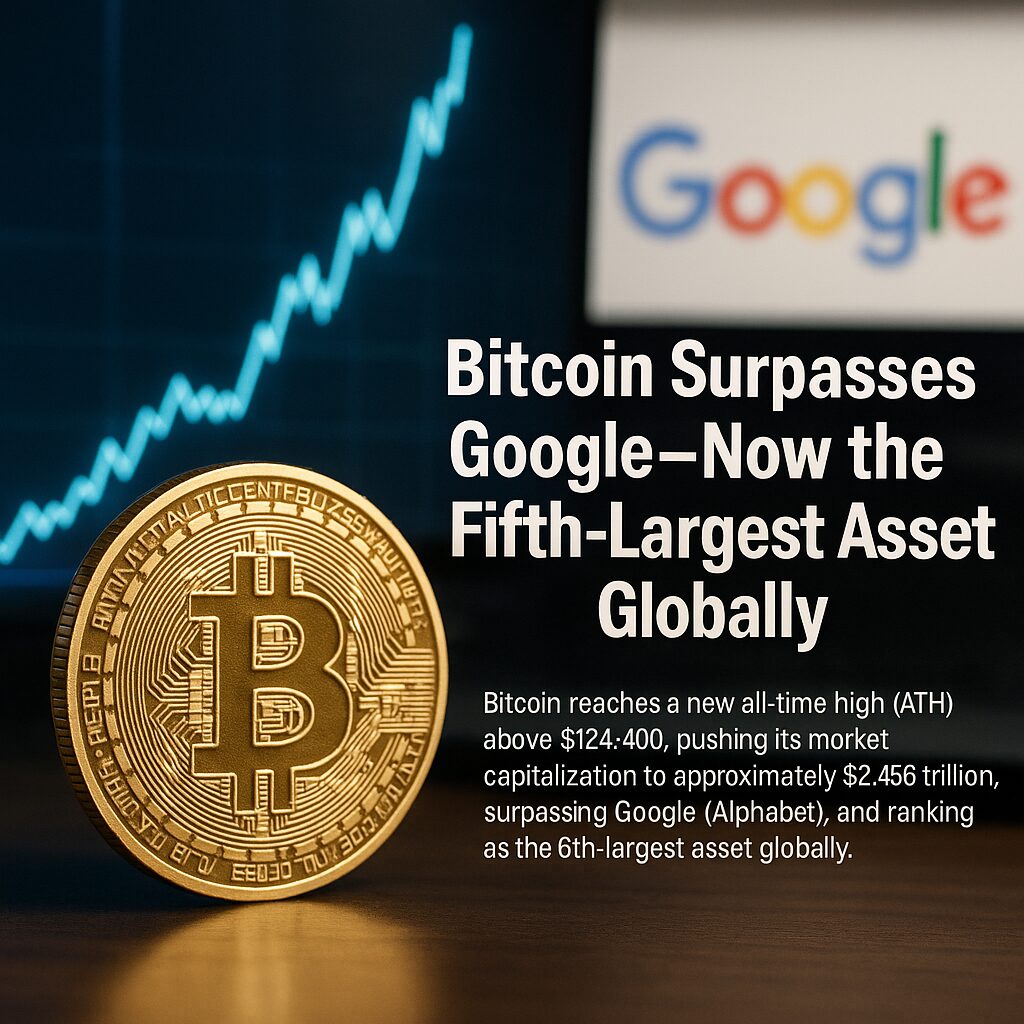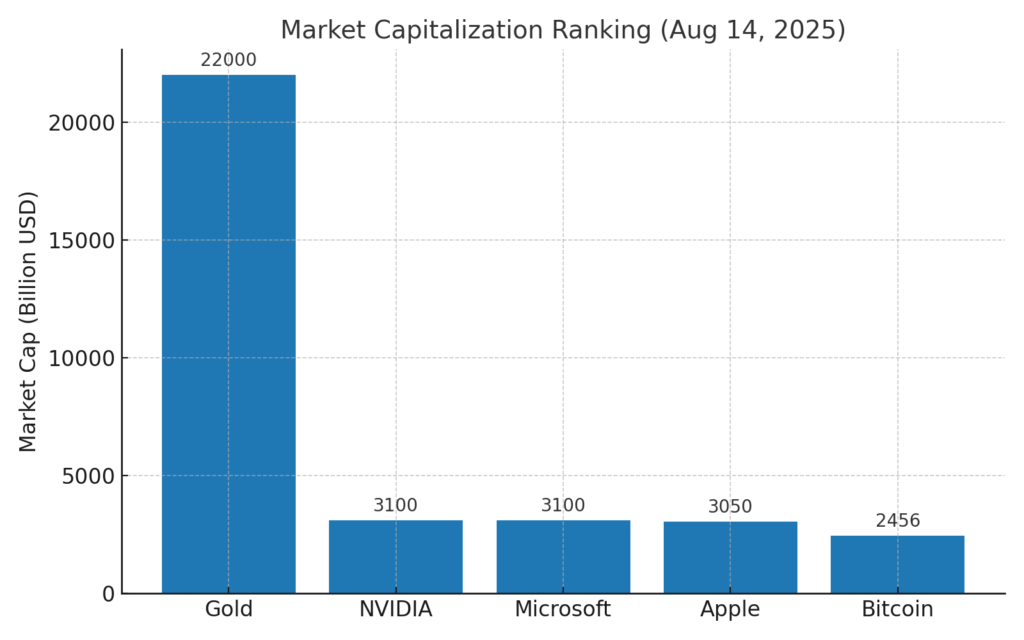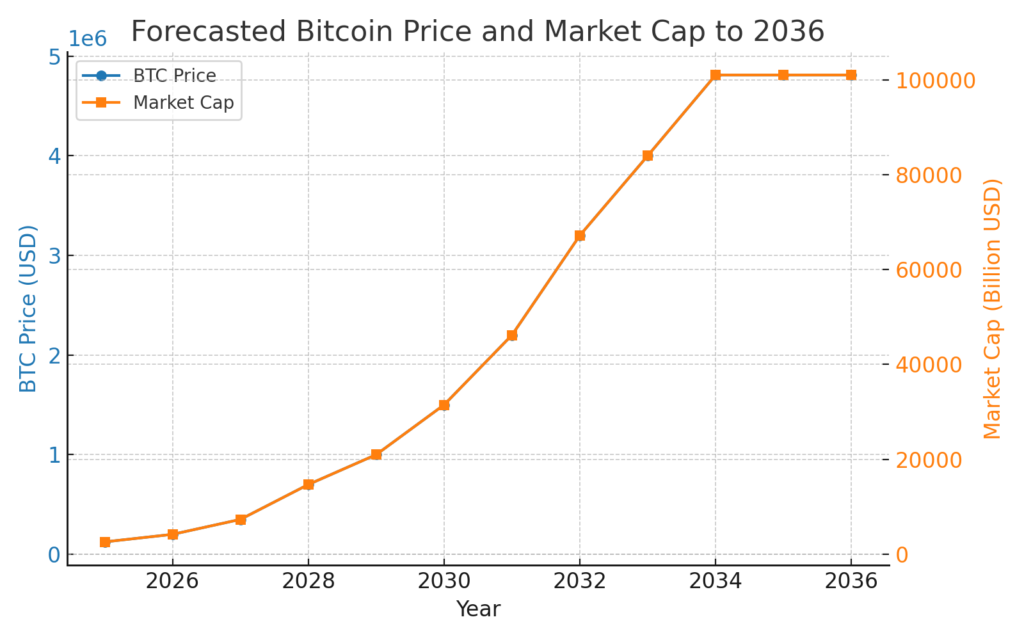
Main Points :
- Bitcoin reaches a new all-time high (ATH) above $124,400, pushing its market capitalization to approximately $2.456 trillion, surpassing Google (Alphabet), and ranking as the 5th-largest asset globally.
- Drivers include expectations of U.S. Federal Reserve rate cuts, institutional demand via spot Bitcoin ETFs, favorable regulatory developments, and corporate treasury accumulation strategies.
- Unique characteristics—decentralization, censorship resistance, capped supply (21 million BTC), and low correlation with traditional assets—continue to underpin its growing appeal as a strategic asset.
- Prominent companies (e.g., MicroStrategy, Tesla; Japanese players such as Metaplanet, Remixpoint) are adopting Bitcoin treasury strategies.
- Forecast models (e.g., Satoshi Action Education) estimate a 75% probability that Bitcoin could reach $4.81 million by April 2036, implying a market cap of ~$88.65 trillion—surpassing gold ($22 trillion).
- Broader trends: In 2024, Bitcoin spot ETFs were approved in the U.S., contributing to enhanced legitimacy and inflows; in March 2025, the U.S. government under Trump established a Strategic Bitcoin Reserve, signaling an unprecedented mainstream embrace.
- Investor sentiment remains bullish—some forecasts now eye $135K–$175K or beyond.
English Article
1. Record-Breaking Milestone: Bitcoin Overtakes Google
Bitcoin achieved a historic feat on August 14, 2025, soaring to a new all-time high of approximately $124,400 per coin. This surge propelled its market capitalization to roughly $2.456 trillion, momentarily surpassing Alphabet (Google) and elevating Bitcoin to the position of the fifth-largest asset globally—only behind gold, NVIDIA, Microsoft, and Apple.

2. Catalysts Behind the Rally
Several intertwined factors fueled this dramatic climb:
- Expectations of U.S. rate cuts and broader monetary easing contributed to a risk-on environment favorable to crypto.
- Institutional demand, particularly via spot Bitcoin ETFs, released in the U.S., is driving billions in inflows. Corporate and institutional buyers—including notable names like MicroStrategy and Metaplanet—are actively accumulating Bitcoin for their treasuries.
- Regulatory clarity and pro-crypto sentiment in Washington—evidenced by legislative momentum and executive-level initiatives—are lending Bitcoin newfound legitimacy.
3. Core Attributes Strengthening Bitcoin’s Appeal
Bitcoin continues to attract strategic interest due to its defining qualities:
- Decentralization and resistance to censorship, offering resilience against geopolitical risks.
- Built-in scarcity with a capped supply of 21 million coins, positioning Bitcoin as a robust inflation hedge.
- Low correlation with traditional assets (stocks, bonds), offering tangible portfolio diversification benefits.
These properties underpin a global trend toward treasury strategies involving Bitcoin. Beyond U.S. firms like MicroStrategy and Tesla, Japanese companies such as Metaplanet and Remixpoint are becoming notable adopters.
4. Lightning Growth and Forward Projections
From its genesis in 2009 to ascending to the fifth-largest asset by 2025, Bitcoin’s rise has been astonishing—and increasingly mainstream. Economists and analysts now propose bold forecasts:
- A predictive model by Satoshi Action Education suggests a 75% likelihood that Bitcoin could reach $4.81 million per coin by April 2036, pushing its market cap to around $88.65 trillion—well above gold’s ~$22 trillion.
- Meanwhile, billionaire investor Philippe Laffont of Coatue Management projects that Bitcoin’s market cap could exceed $5 trillion within the next five years, driven by institutional adoption and legitimization.

5. Structural Shifts and Institutional Endorsements
Bitcoin’s ascent has been bolstered by structural developments and government-level support:
- In 2024, U.S. regulators authorized spot Bitcoin ETFs, catalyzing institutional entry and retail participation.
- In March 2025, the Trump administration signed an executive order establishing a Strategic Bitcoin Reserve and a broader digital asset stockpile—formalizing Bitcoin’s role within national-level financial strategy.
6. Market Sentiment and What Lies Ahead
Investor sentiment has turned exuberant. Analysts have shifted their eyes past $124K, with new targets ranging from $135K to as high as $175K or beyond. The convergence of ETF inflows, favorable policy developments, and macroeconomic uncertainties continue to support further momentum.
Conclusion
In summary, Bitcoin’s ascent to become the world’s fifth-largest asset—outranking Google in market capitalization—is no fleeting event but a culmination of shifting fundamentals. Fueled by institutional adoption, ETF inflows, regulatory clarity, and macroeconomic forces, Bitcoin’s core attributes of scarcity, decentralization, and diversification value continue to secure its strategic relevance. With forward-looking analyses projecting explosive long-term growth and even sovereign-level recognition, Bitcoin is not merely a speculative token—it is an increasingly entrenched pillar of the global financial ecosystem.

